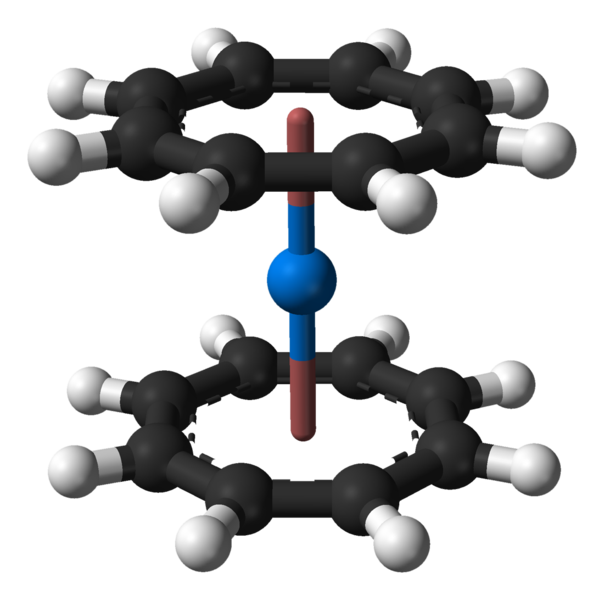Science
Related: About this forumA Polly Arnold Review on the Organometallic Chemistry of Neptunium.
Last edited Sun Sep 17, 2017, 03:28 AM - Edit history (1)
There's this great video by Norah Jones during a tribute to Graham Parsons where in preface to performing his song "She" she declares that on listening to every song performed at the tribute she said, "Oh that's my favorite song..." and then declares that "But this is really my favorite song..." (It's a wonderful performance.)
My kid, who I am happy to report is visiting me this weekend - coming home from college to celebrate my birthday - always laughs at me because every time I see a poster on a wall in a university building referring to the chemistry of element - any element - I say "That's my favorite element..."
"Dad," he says, "Every element is your favorite element." (That's not true. I don't care all that much about the chemistry of terbium, or for that matter lutetium.)
One of my favorite elements, really, is the element neptunium, since I regard it as a key to decreasing the risk of nuclear war as close to zero as is possible, via the "Kessler Solution." (We cannot uninvent nuclear weapons, nor can we ever eliminate the risk of nuclear war, since the supply of uranium is inexhaustible. I explored this point elsewhere: On Plutonium, Nuclear War, and Nuclear Peace
In another post on the same website I wrote about some interesting chemistry associated with the actinide elements, noting that the Nobel Laureate who had, in many ways, the greatest effect on day to day life of any Nobel Laureate, Fritz Haber, since despite its greatly problematic environmental consequences, the world's food supply depends on the Haber process, noted very early on that uranium was likely to be wonderful catalyst for nitrogen fixation: Uranium Catalysts for the Reduction and/or Chemical Coupling of Carbon Dioxide, Carbon Monoxide, and Nitrogen. In that post, I discussed the work of Polly Arnold, a world leader in organoactinide chemistry.
Now Dr. Arnold has written a review article in one of my favorite journals, Chemical Reviews:
Organometallic Neptunium Chemistry (Chem. Rev., 2017, 117 (17), pp 11460–11475)
An excerpt from the text:
The density of neptunium, is, by the way, 19.5 tons per cubic meter, meaning that all the neptunium produced each year would fit into a cube 130 centimeters on a side. (This compares favorably with dangerous fossil fuel waste which at 30 billion tons per year, can never be contained under any circumstances.) However no one could ever construct such a cube, since 19.5 tons of neptunium greatly exceeds its critical mass, and this being true, the element is a very wonderful potential nuclear fuel.
50 tons of neptunium is a very valuable resource, especially because of the very interesting property metallic neptunium has of forming a low melting eutectic with metallic plutonium that makes for interesting possibilities for the LAMPRE type reactors that were explored by a generation smarter than ours, in the mid twentieth century.
One hopes that a future generation, smarter than ours, will utilize this neptunium resource to clean up the intractable mess with which our irresponsibility and dumb assed ideas and fantasies has left them.
They may not, and should not, I think, forgive us.
Chemical Reviews, as an aside, is a wonderful place for chemists to catch up in areas in which they are non-specialists. I love that journal.
Enjoy the rest of the weekend.
eppur_se_muova
(36,257 posts)Just kidding. ![]() I have no idea what it's good for, besides yet another plug for the town of Ytterby, Sweden. (OK, you can probably make phosphors and NMR shift reagents from it. But that's true of most lanthanides.)
I have no idea what it's good for, besides yet another plug for the town of Ytterby, Sweden. (OK, you can probably make phosphors and NMR shift reagents from it. But that's true of most lanthanides.)
sharedvalues
(6,916 posts)Your excerpt is about the decay and nuclear reactions of neptunium.
I clicked here expecting chemistry. Bait and switch ![]()
NNadir
(33,512 posts)...in a classic role, cyclopentaldienyl ligands...

...neptunocene...

and is a special guest appearance, uranium, in the role of "reaction intermediate in the formation of heterobimetallic complex"

...after an award winning performance as "Uranium and manganese assembled in a wheel-shaped nanoscale single-molecule magnet with high spin-reversal barrier..."
